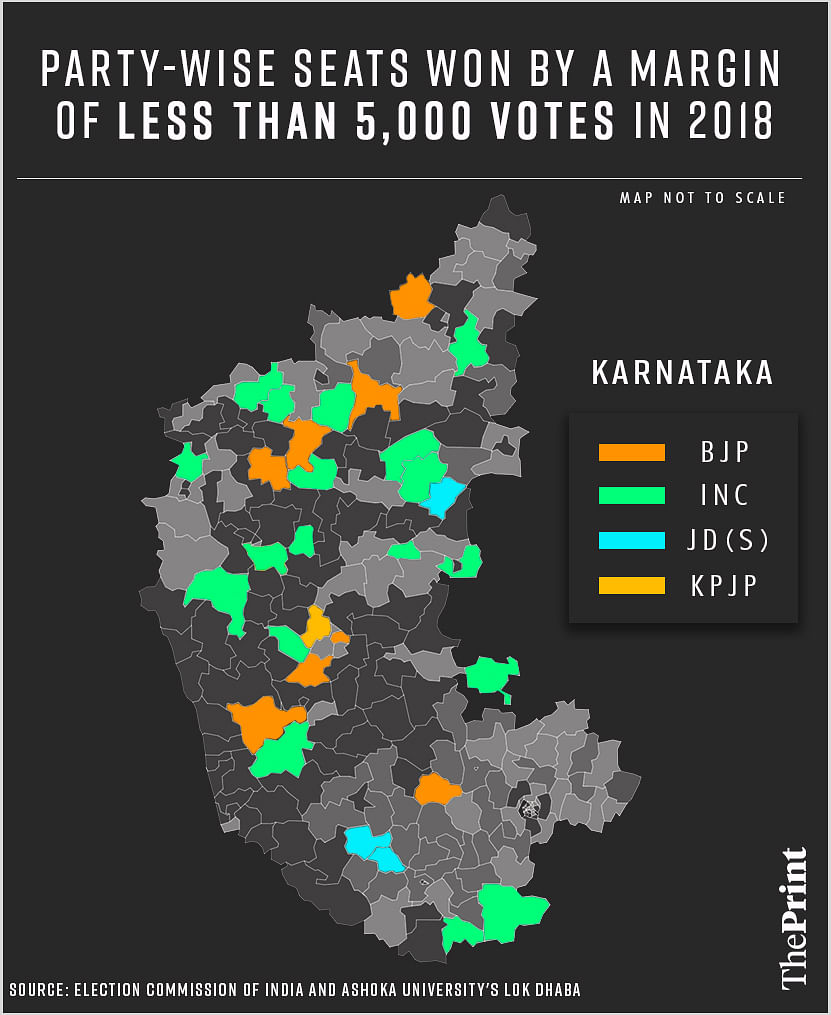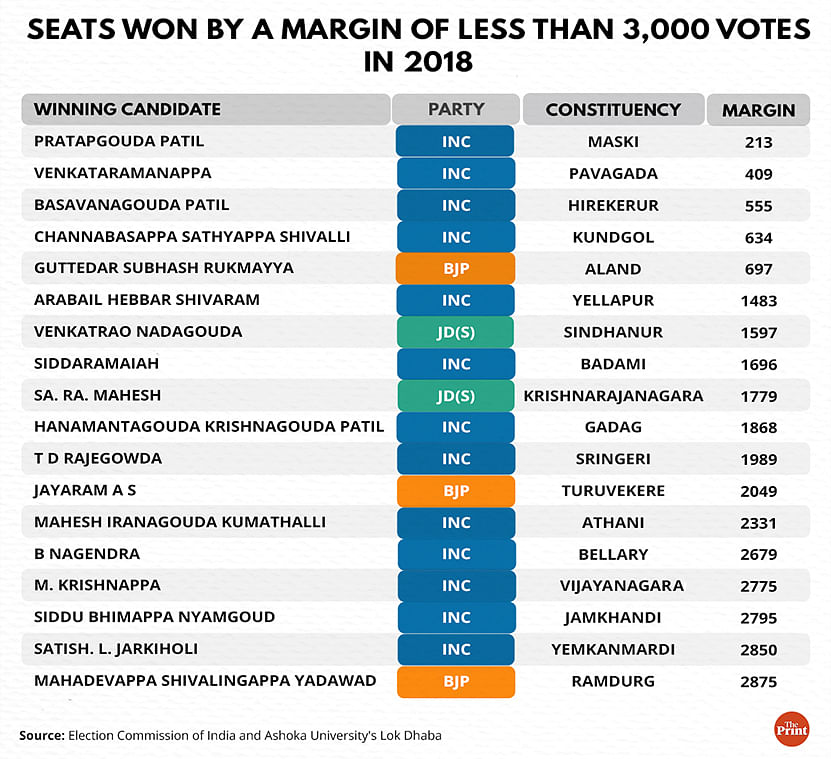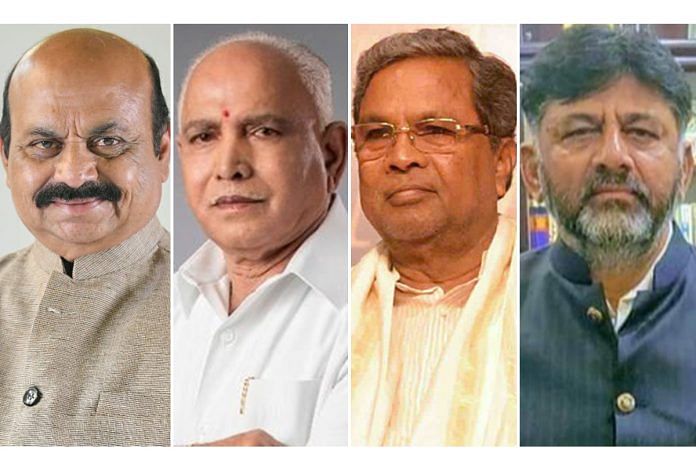New Delhi: In 2018, the Bharatiya Janata Party (BJP) lost 16 seats in Karnataka with a margin of less than 5,000 votes, an analysis of election data from that year’s assembly election shows. Of these, the party lost 12 seats by a margin of less than 3,000 votes.
The BJP won 104 of the state’s 224 seats, emerging as the single largest party. But the Congress, which won 78 seats, cobbled together a post-poll alliance with the Janata Dal (Secular), which had won 37 seats, to form a government which lasted for only 14 months.
Although the BJP came to power in 2019 thanks to 17 defectors from the Congress-JD(S) alliance, data shows that these 16 seats — where the BJP lost on account of less than 5,000 votes — could have decisively swung the election its way.

With voting set to take place on 10 May and the counting of votes on 13 May, things stand slightly different this time, especially with smaller parties in the fray.
For instance, Asaduddin Owaisi’s All India Majlis-e-Ittehadul Muslimeen (AIMIM) is set to contest in 25 of the total 224 seats, while Social Democratic Party of India (SDPI), the political wing of the outlawed Popular Front of India (PFI), is set to field its candidates in 100 seats. SDPI had claimed in 2018 that it had an “understanding” with the Congress.
These smaller parties are expected to eat into the Muslim votes of the Congress and the JD(S), which is likely to be a major worry for the two key players in Karnataka.
Then, there are parties like G. Janardhana Reddy’s Kalyana Rajya Pragathi Paksha (KRPP) and the Aam Aadmi Party (AAP).
Miffed with the BJP, mining baron and former BJP minister Reddy floated his own party, the KRPP, last December. In February, it was announced that he was going to contest the election against his brother, sitting BJP MLA Somashekhar Reddy, from Ballari. Reddy’s candidature could also spell trouble for the Congress, especially since he could split the anti-incumbency votes against the Bommai government.
The AAP, meanwhile, declared in January that it was going to field candidates on all 224 seats.
Smaller parties are a matter of concern in seats where the victory margin was slim in 2018, say political experts. And these 30 seats could make all the difference.
“In a close fight, even if they (small parties) can take away 3,000-4,000 votes, it’s a lot. That’s the role they play. They cannot win an election, but can certainly alter situations in different constituencies,” Bengaluru-based political analyst and faculty at the National Institute of Advanced Studies (NIAS) Narendar Pani told ThePrint.
It’s also significant to note that Congress won 18 of the 30 seats where the margin of victory was less than 5,000 votes in 2018. The BJP, on the other hand, won eight such seats and the JD(S) three.
One of the candidates who won with a margin of under 2,000 votes was former chief minister Siddaramaiah. The Congress leader contested from two seats that year — Badami and Chamundeshwari. While he won Badami by 1,696 votes, he lost Chamundeshwari, the seat he represented earlier, to G.T. Devegowda of the JD(S) by nearly 36,000 votes.
Chambi Puranik, a retired professor of political science from the University of Mysore, told ThePrint that candidates have to be even more careful in such seats.
“If the particular candidate has done well, remained connected with the people of the constituency, then yes, he definitely stands a better chance. And if individually he hasn’t done, then well, (voters) could forget a party but they watch the individual,” he said.
Also Read: If Congress needs lessons in election management, it just needs to look at its Karnataka unit
Defectors, ministers & those on the fence
Of the 17 rebels that helped bring down H.D. Kumaraswamy-led Congress-JD(S) government in 2019, five — Yellapur MLA Arabail Hebbar Shivaram, Athani MLA Mahesh Kumathalli, Ranibennur MLA R. Shankar, Hirekerur MLA and then agriculture minister B.C. Patil and Maski MLA Pratap Gouda Patil — had won with less than 5,000 votes.

Additionally, S.R Mahesh of the JD(S), who has been representing the Krishnarajanagara seat since 2008, saw his victory margin narrow that year. The MLA, who won in 2013 by a margin of 15,000 votes, saw his margin of victory reduce to just over 1,700 in 2018.
Likewise, Congress MLAs M. Krishnappa (Vijaynagar) and R. Narendra (Hanur), who won their seats in 2008 and 2013 by a significant margin (Krishnappa: 38,000 in 2008 and 11,500 in 2013; Narendra: 23,000 in 2008, and 32,600 in 2013), just about crossed the finishing line in 2018, winning by over 2,700 and 3,500 votes.
Another heavyweight with a slim margin of victory in 2018 was former JD(S) state president H.K. Kumaraswamy who won his current seat, Sakleshpur — which he has represented in 2008 and 2013 — by a margin of less than 5,000 votes.
Mumbai-Karnataka & Lingayat factor
A significant number of seats that saw a close fight in 2018 were from the Kittur Karnataka region, formerly known as Mumbai-Karnataka. Today, the region comprises seven districts, namely Uttara Kannada, Belagavi, Dharwad, Vijayapura, Bagalkote, Gadag and Haveri.
Of all the 30 seats where the margin of victory was less than 5,000 votes in 2018, a dozen came from this region. Congress won eight of those seats and the BJP won three.
One seat, Rannibennur, went to the Karnataka Pragnyavantha Janatha Party (KPJP) and was won by a margin of 4,300 votes. The party was founded in 2017 by Puthurina Muthu D. Mahesh Gowda and uses an auto-rickshaw as its election symbol.
Politically, the Kittur Kannada holds a significant place in Karnataka’s politics. Not only does it send 50 MLAs to the assembly but the current chief minister, Basavaraj Bommai, a Lingayat, belongs to the region which has a sizable presence of the community. Dominant players in Karnataka’s politics, they are traditionally considered close to the BJP — primarily because of former chief minister B.S. Yediyurappa, a prominent Lingayat leader.
In 2018, BJP lost seven seats in this region by a margin of less than 5,000 votes. In Athani, then Congress candidate Mahesh Kumathalli beat his closest rival, Laxman Sangappa Savadi, by 2,331 votes.
“All districts except Uttara Kannada have Lingayat voters in significantly large numbers. Historically, they have been voting on the name of a stalwart Lingayat leader, be it Veerendra Patil (Congress) or B.S. Yediyurappa (BJP),” the Deccan Herald quoted Belagavi-based political analyst Ashok Chandargi as saying on 7 March.
The margin of victory was also narrow on at least six seats each in the Hyderabad-Karnataka or Kalyana-Karnataka, and South Karnataka regions.
Closest fights
The 2018 assembly saw wafer-thin victory margins in five seats — Maski, Kundgol, Hirekrur, Pavagada and Aland. The victory margins here were less than 1,000 votes.
In Maski, the Congress candidate, Pratap Gowda Patil, who later defected to the BJP, won by 213 votes.
Such narrow margins were also witnessed in Kundgol, Hirekerur and Pavagada, where Congress candidates won by 634, 555 and 409 votes. Only other candidate with such a slim victory was BJP’s Guttedar Subhash Rukmayya, who won Aland by 697 votes.
Patil eventually lost the seat to Basanagouda Turvihal, a former BJP leader who switched over to the Congress, in the 2021 by-election.
Despite this, there were Congress leaders who won with significant margins. Chief among them was R. Akhanda Srinivasamurthy, who won the Pulakeshinagar seat by a margin of 81,626 votes and Congress heavyweight D.K. Shivakumar, who won Kanakapura by a margin of 79,909 votes.
Puranik believes this election could be harder for the Congress candidates who merely scraped by the last time. “If it is a Congress candidate who won by a thin margin, he is more at risk. But a BJP candidate might have a better chance because of the double engine government and Modi-Yediyurappa factor,” he told ThePrint.
(Edited by Uttara Ramaswamy)
Also Read: In Karnataka, Deve Gowda asks a powerful question: ‘Is a regional party needed or not?’



